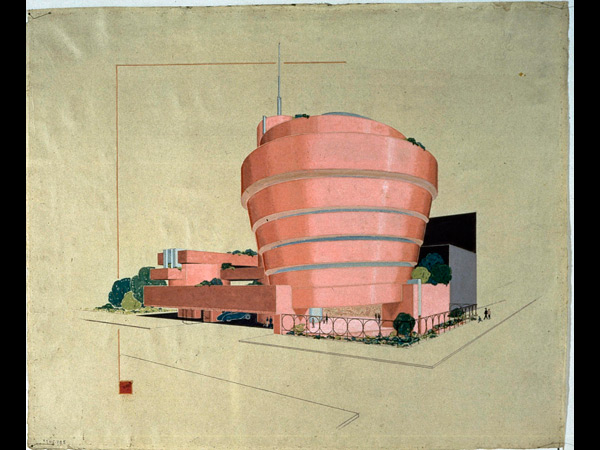The height of "gravity-defying" artistic hubris in recent years has been the Bilbao Effect – the phenomenon of "destination architecture," with cities focusing investment in showpiece cultural institutions as part of urban renewal schemes, trying to clone the rejuvenating effect that Frank Gehry’s Guggenheim had on industrial Bilbao. . . .I found the reference to this story in a new piece: The Museum Bubble, which is also worth a read.
The "Bilbao" formula has had wide success because it brings together a progressive-sounding rhetoric about civic investment with means that are appealing to the wealthy and the established. Today, with income disparity in the U.S. as high as it has been since right before the Depression, the lesson . . . is that, until investment in culture is wed to a more sane economic investment for all, the strategy is like an urbanist version of the Atkins Diet: It may produce quick, superficially pleasing results; it also starves you of needed nutrients, hurts your heart and makes you stink.
observations, opinions, and the occasional rant
about museums and their visitors, programs, and architecture.
August 14, 2009
Ben Davis on the Bilbao Effect
Ben Davis' piece Glass Houses is a couple of years old (and is somewhat misguided in dumping on Toledo), but is prescience about the real effect of the "Bilbao effect."
More on the Guggenheim at 50

Slate has a very good historical slideshow about Frank Lloyd Wright and the growth and development of the Guggenheim Museum. The focus is unusual as it is as much on the development of the collection as it is about the building itself.
It is astonishing that a museum that is 50 years old still generates controversy, but in many ways the Guggenheim is ur-project that posed the question we still wrestle with: Which comes first, the art or the architecture? It is not surprising where Wright comes down:
architecture is "the Mother-art of which Painting is but a mere daughter"Artists, and some curators, might differ, as they did, vociferously, when the Guggenheim first opened.
August 11, 2009
Engaging Audiences

This is somewhat off topic, but perhaps is more pertinent than it seems. If we are building museums, it is critical to understand who the museum is for.
The Wallace Foundation's new report on Engaging Audiences focuses primarily on performing arts organizations, but many of the lessons are equally applicable to museums. Much of this is not new, but the report is direct and succinct nd well worth circulating.
August 7, 2009
Gehry on throwing architecture under the bus
Frank Gehry is quoted in an NPR story about the 50th anniversary of the Guggenheim Museum in New York. The story is worth reading on its own as it describes the impact the Wright's design had on the museum world. Most interesting, though, are Frank Gehry's comments at the end:
. . . the architect says, it's getting harder to build works with "spirit, passion and feeling."I agree that it would be sad to see a return to "straight simple, minimalist, idiocy." But I also think it would be wonderful to achieve more balance, to move past the truly idiotic notion that every new museum must be a unique architectural expression. It would be delightful if every museum could be designed by the likes of Gehry, but even among the architectural luminaries, few can compare with his mastery of both form and function. A few more simple green boxes would meet the needs of many museums and their users at considerably less cost than the bloated attempts at artistic expression that have hobbled some museums.
"I think that throwing architecture under the bus is being touted by the people who can't do the other," Gehry says. "And this is a great excuse to trash those who can, and say we're through with those guys, and now we're going back to straight simple, minimalist, idiocy again. Cold simple sterility. It's got to be green, though! As long as it's green, you're OK."
August 4, 2009
The Future of Museum Architecture?
A recent piece in the NY Times described the conversion of a grain elevator into an art gallery. (“About the only thing we can’t offer, is white walls.”) With the debunking of the "Bilbao Effect" myth that hiring a star architect can transform any city, is this an indicator of a possible return to a more inventive kind of architecture that is rooted in the needs of artists and visitors (rather than the egos of community leaders)?
One of my favorite recent museums continues to be MassMOCA in North Adams, Massachusetts. Not because it is great architecture, but because it is an interesting and surprising place to experience art. Rather than creating a grand statement--"This is architecture" as the new starchitect museums do, MassMOCA encourages dialog between artists and the buildings. This dialog then extends to the visitors and invites them to join in the discussion, rather than simply stand back in awe of the art, or, in too many cases, the building.
Engaged dialog is certainly a more contemporary (and less Medieval) expression of the ways our social discourse is evolving. Facebook and all the other Web 2.0 technologies are transforming the ways people engage with each other and with the organizations and activities they enjoy. Museums are beginning to get on board in digital space ("follow us on Twitter!"). Perhaps the grain elevator project is the latest manifestation of a new, more personal, way of thinking about engaging people with art in physical space?
Subscribe to:
Posts (Atom)